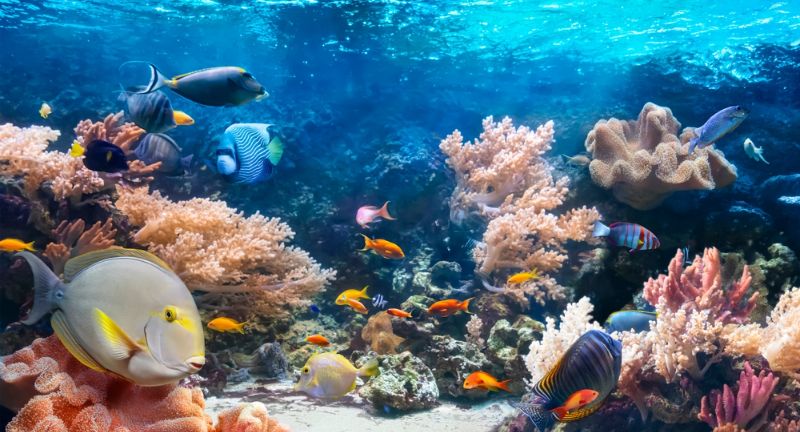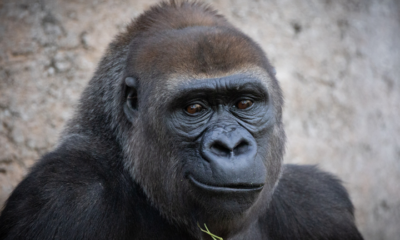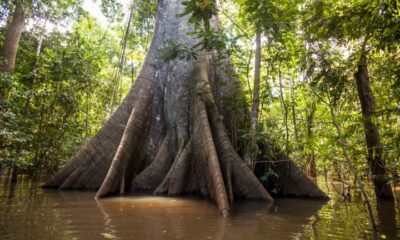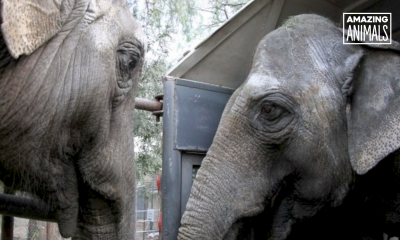ANIMALS
26 Fascinating Facts About Coral Reefs
Published
3 months agoon

Shutterstock
Coral reefs are some of the most extraordinary ecosystems on Earth, showcasing unparalleled biodiversity and breathtaking beauty. These underwater marvels are created by tiny coral polyps, whose combined efforts build massive reef structures visible even from space. Beyond their visual allure, coral reefs play a crucial role in supporting marine life, protecting coastlines, and offering medicinal and economic benefits. However, these fragile habitats are increasingly under threat from climate change, pollution, and human activities. Exploring the fascinating world of coral reefs reveals their importance and the urgent need to preserve these natural wonders.
Animal Builders

Shutterstock
Corals may look like colorful underwater plants or rocks, but they are actually animals. Each coral is composed of tiny, soft-bodied organisms called polyps, which live together in a structure called a colony. These polyps build skeletons around themselves for protection, which gives corals their unique shapes. Their animal nature often surprises people, adding to the fascination with these remarkable marine organisms.
Colonial Creatures

Shutterstock
Most coral species live in colonies composed of thousands or even millions of individual polyps. These polyps are genetically identical and work together to form the reef structure, sharing resources and protecting one another. The interdependence of these tiny creatures highlights the importance of teamwork in nature. Coral colonies create some of the most complex and beautiful underwater habitats on Earth.
Hard and Soft Corals

Shutterstock
There are two main categories of coral: hard corals and soft corals. Hard corals are responsible for building the strong, limestone skeletons that create the foundation of coral reefs. In contrast, soft corals are more flexible and often resemble underwater plants or fans swaying in the current. Both types play vital roles in their ecosystems, showcasing the diversity of coral life.
Skeleton Formation

Shutterstock
Hard corals produce calcium carbonate, or limestone, to create rigid skeletons. These skeletons accumulate over generations, forming massive reef structures that can be seen from space. This process takes centuries or even millennia, making coral reefs some of the oldest living structures on Earth. Their enduring presence provides critical habitats for countless marine species.
Symbiotic Algae

Shutterstock
Many corals have a symbiotic relationship with tiny algae called zooxanthellae. These algae live inside the coral’s tissues and provide nutrients through photosynthesis, giving corals both energy and vibrant colors. This partnership is vital for the health of coral reefs, as the algae supply the majority of the corals’ food. Without this relationship, coral reefs would not be the thriving ecosystems we know today.
Importance of Light

Shutterstock
Corals thrive in clear, shallow waters because their symbiotic algae require sunlight to produce food. This is why coral reefs are typically found in tropical or subtropical waters, usually less than 30 meters deep. The availability of sunlight directly influences the growth and vibrancy of coral reefs. In murky or deep waters, corals struggle to survive, making them highly sensitive to water clarity and light conditions.
Global Distribution

Shutterstock
Corals are not confined to tropical regions; they are found in every ocean. While warm-water reefs are well-known, deep-water corals thrive in colder, darker environments like the Arctic or off European coasts. These hardy species survive without sunlight, relying on organic matter drifting from the surface. This global distribution showcases the adaptability and diversity of corals.
Old Growth

Shutterstock
Coral colonies can live for thousands of years, with some deep-sea corals estimated to be over 4,000 years old. These ancient organisms provide invaluable insights into past oceanic and climatic conditions. Their slow growth rates make them vulnerable to rapid environmental changes, underscoring the need for their protection. These living time capsules are a testament to the longevity of Earth’s marine ecosystems.
Reef Biodiversity

Shutterstock
Coral reefs are often called the “rainforests of the sea” because they support an incredible diversity of life. Despite covering less than 1% of the ocean floor, they provide habitat for about 25% of all marine species. From tiny plankton to large predators, reefs are bustling hubs of activity. This biodiversity makes coral reefs vital to the health of the global ocean ecosystem.
Natural Breakwaters

Shutterstock
Coral reefs act as natural barriers, absorbing wave energy and protecting coastlines from erosion and storm damage. They help reduce the impact of flooding and safeguard coastal communities. Reefs also support surrounding ecosystems like mangroves and seagrass beds by stabilizing sediments. Their protective role emphasizes the importance of preserving these natural breakwaters.
Spawning Events

Shutterstock
Many coral species reproduce through synchronized mass spawning events. These events occur under specific moon phases and temperature conditions, with corals releasing eggs and sperm into the water simultaneously. The spectacle increases the chances of fertilization and ensures the survival of new coral generations. This natural wonder is a key part of coral life cycles and reef regeneration.
Coral Bleaching

Shutterstock
Coral bleaching occurs when corals expel their symbiotic algae due to stress from warming waters, pollution, or other factors. This loss causes the corals to turn white, signaling a dire threat to their health. If conditions don’t improve, bleached corals may die, leading to reef degradation. Bleaching events are stark reminders of the vulnerability of coral reefs to environmental changes.
Temperature Sensitivity

Shutterstock
Corals are highly sensitive to temperature changes, with just a few degrees above their normal range triggering bleaching. Prolonged exposure to elevated temperatures can result in coral mortality. This sensitivity makes coral reefs essential indicators of climate change and ocean warming. Their reaction to temperature fluctuations highlights the urgent need for global efforts to mitigate climate impacts.
Medicinal Benefits

Shutterstock
Coral reefs are a treasure trove of potential medical breakthroughs. Scientists have discovered compounds in corals and reef organisms that could help fight cancer, arthritis, and bacterial infections. These unique chemicals highlight the importance of protecting reefs, as their loss could mean missing out on life-saving discoveries. Coral ecosystems not only sustain marine life but also hold immense value for human health advancements.
Nutrient Cycling

Shutterstock
Corals and their symbiotic algae form efficient nutrient recycling systems in nutrient-poor tropical seas. This relationship helps maintain a delicate ecological balance in waters where resources are scarce. By converting sunlight into energy and cycling nutrients, corals support a diverse range of marine species. Their role as nutrient recyclers underscores their importance in maintaining healthy ocean ecosystems.
Creative Coral Polyps

Shutterstock
Coral polyps have a dual feeding strategy to sustain themselves. At night, they extend their tentacles to catch plankton and small organisms drifting by. During the day, they rely on their symbiotic algae to produce energy through photosynthesis. This ingenious combination ensures a steady food supply, even in nutrient-scarce waters.
Colorful Pigments

Shutterstock
Some corals possess fluorescent pigments that protect their symbiotic algae from intense sunlight. These pigments can absorb and dissipate harmful UV rays, ensuring the algae’s survival. Additionally, they create the vibrant and glowing colors corals are famous for, especially under certain lighting conditions. This natural sunscreen demonstrates the corals’ adaptability to harsh environments.
Coral Gardening

Shutterstock
Coral gardening is a conservation method used to restore damaged reefs. Healthy coral fragments are cultivated in underwater nurseries and later transplanted onto degraded reef sections. This process helps accelerate reef recovery and enhances biodiversity. Coral gardening initiatives worldwide are vital for preserving these ecosystems for future generations.
Deep-Sea Secrets

Shutterstock
Deep-water corals, unlike their shallow counterparts, do not depend on sunlight or zooxanthellae. Instead, they survive in darkness by feeding on organic particles drifting down from the surface. Found in depths exceeding 200 meters, these corals form cold-water reefs that support unique ecosystems. Their ability to thrive in such extreme environments showcases the resilience of coral species.
Geological Archives

Shutterstock
Coral skeletons serve as geological archives, with growth rings and chemical signatures revealing past climate and ocean conditions. Scientists study these layers to understand historical sea temperatures, pollution levels, and oceanic changes. This data is crucial for predicting future environmental shifts and the impacts of climate change. Corals are not just marine organisms but also valuable recorders of Earth’s history.
Massive Structures

Shutterstock
The Great Barrier Reef in Australia is the largest coral reef system on Earth. Spanning over 2,300 kilometers, it is so vast that it can be seen from space. This natural wonder consists of thousands of individual reefs and islands, providing a home for an extraordinary array of marine life. Its sheer size and biodiversity make it one of the most remarkable ecosystems on the planet.
Mutualism at Work

Shutterstock
The relationship between coral polyps and zooxanthellae algae is a prime example of mutualism. The corals provide the algae with a safe home and carbon dioxide, while the algae supply oxygen and sugars through photosynthesis. This partnership is crucial for the survival and growth of coral reefs. Without this mutualistic bond, coral ecosystems as we know them would not exist.
Fragile Habitat

Shutterstock
Coral reefs are incredibly delicate and can be damaged by even minor human disturbances. Sediment runoff from construction, overfishing, and anchor damage are just a few of the threats they face. Their intricate balance makes conservation efforts essential to their survival. Protecting reefs ensures that they continue to support marine biodiversity and provide vital ecosystem services.
Acidic Oceans

Shutterstock
Rising carbon dioxide levels in the atmosphere lead to increased CO2 absorption in oceans, making the water more acidic. This reduced pH weakens coral skeletons and slows their growth, threatening the future of reef ecosystems. Ocean acidification is a growing problem that poses serious risks to coral survival. Addressing CO2 emissions is critical to preserving coral reefs and their ecological functions.
Incredible Diversity of Shapes

Shutterstock
Coral colonies display a stunning variety of shapes and textures, from branching forms resembling elk antlers to plate-like structures and delicate fans. This diversity contributes to the visual complexity and beauty of reefs. The unique shapes also serve functional purposes, such as maximizing light absorption or creating shelter for marine life. Their adaptability is a testament to the evolutionary ingenuity of coral species.
Cultural and Economic Importance

Shutterstock
Coral reefs are not only ecological treasures but also hold significant cultural and economic value. They provide fishing grounds, tourism income, and coastal protection for millions of people worldwide. Beyond their environmental benefits, reefs contribute to the livelihoods and traditions of coastal communities. Preserving these ecosystems is vital for both their natural beauty and their role in supporting human well-being.
Conclusion

Shutterstock
Coral reefs are a testament to the intricate beauty and resilience of nature, but they also serve as a stark reminder of the fragility of our environment. As critical habitats for marine life and natural barriers for coastal protection, their preservation is essential for ecological and human well-being. With climate change and human activities threatening their existence, urgent action is needed to protect and restore these underwater treasures. By learning about coral reefs and advocating for their conservation, we can help ensure their survival for future generations. Their vibrant beauty and ecological importance make them worth every effort to protect.
More Amazing Animals+
-


29 Caterpillars That Look More Like Fuzzy Aliens Than Animals
-


Don’t Let This Bird Fool You
-


25 Mythical And Misunderstood Animals
-


30 Smartest Animals In The World
-


Rokka’s trunk might not yet be big enough to properly…
-


28 Animals That Use Camouflage For Protection
-


31 Reasons Porcupines Are Even Cuter Then They Look
-


Why We Love Penguins
-


Boris the bear beating the heat at the Milwaukee County…
-


The Bearded Dragon: A Surprising Guide to Your New Favorite…
-


24 Most Interesting Facts About The Amazon River
-


Elephant Mother And Daughter Get New Home With Room To…
